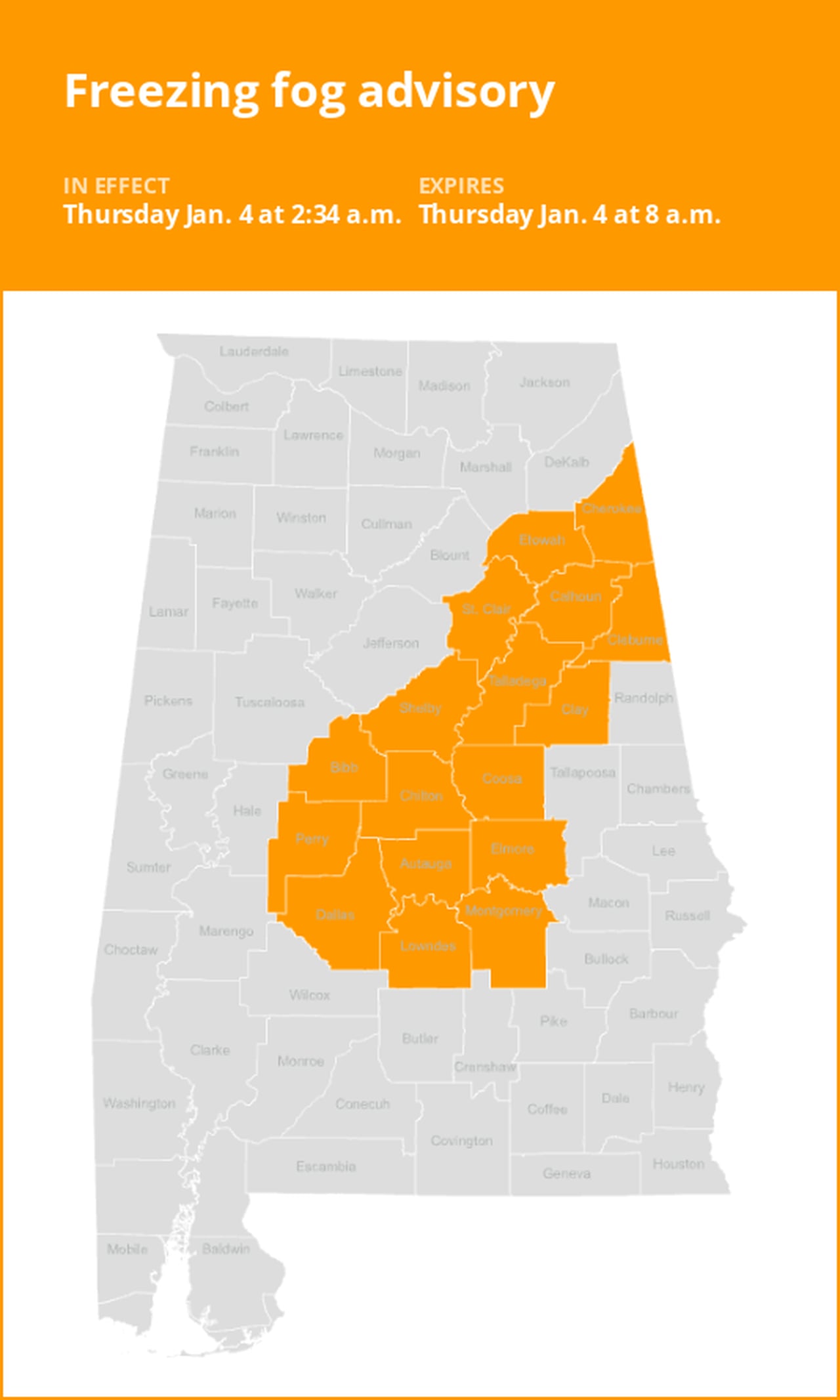Freezing fog advisory for Central Alabama until Thursday morning
On Thursday at 2:34 a.m. a freezing fog advisory was issued by the National Weather Service in effect until 8 a.m. for Etowah, Calhoun, Cherokee, Cleburne, Shelby, St. Clair, Talladega, Clay, Perry, Bibb, Chilton, Coosa, Dallas, Autauga, Lowndes, Elmore and Montgomery counties.
The weather service says, “Visibility one quarter mile or less in freezing fog.”
“Hazardous driving conditions due to low visibility and potential frost on bridges,” states the weather service. “If driving, slow down, use your headlights, and leave plenty of distance ahead of you. Also, be alert for frost on bridge decks causing slippery roads.”
Understanding freezing fog advisories
A freezing fog advisory, issued by your local weather service office, comes into play when fog forms concurrently with surface temperatures at or below freezing. This unique atmospheric condition leads the minuscule liquid droplets within the fog to freeze instantaneously upon contact with surfaces, encompassing everything from vehicles to roadways. The arrival of freezing fog significantly heightens the risks associated with various modes of transportation, including driving, boating, and flying. Typically, this meteorological phenomenon reduces visibilities to one mile or less, amplifying the challenges of navigation in these frosty conditions.
What is a freezing fog?
Freezing fog, a close cousin to ice, forms the same way as regular fog. Both fog and freezing fog start when the skies are clear, heat radiates into space, and as a result, the Earth’s surface cools down. As this cooling progresses, the air’s capacity to retain moisture decreases, triggering the condensation of water vapor into minuscule liquid droplets — the essential components of fog. When this fog forms in sub-zero temperatures, its water droplets remain in liquid form, a phenomenon known as “Supercooling”. In essence, supercooling occurs when a liquid, despite being below its freezing point, remains in a liquid state due to the absence of a freezing surface.
When these supercooled droplets encounter surfaces, they undergo a remarkable transformation, crystallizing into delicate ice structures known as rime. This transformation is often visible on vertical surfaces exposed to prevailing winds, as well as on trees, plants, and other elements in the environment. In fact, rime can form on a variety of surfaces, including stairs, railings, sidewalks, roads, and even vehicles.
What is black ice?
Black ice, also known as clear ice, refers to a delicate, nearly invisible layer of glaze ice that forms on various surfaces, especially on roadways. Despite its name, the ice is not black, but possesses exceptional transparency, enabling the underlying black pavement of the road, to remain visible.
The formation of black ice is frequently attributed to freezing fog, which can swiftly coat roadways with this treacherous hazard. Its near-invisibility renders black ice exceptionally perilous, as it poses a significant challenge for road users to detect.
How to stay safe?
When freezing fog blankets your surroundings, the safest course of action may entail avoiding travel if at all possible. If venturing out becomes an inevitability, exercise utmost caution and heed these essential safety guidelines:
High vigilance:
- Be vigilant, as freezing fog can give rise to the notorious black ice, which remains elusive and challenging to spot.
Reduce speed:
- Drive at a reduced pace, especially when icy conditions are suspected.
Visibility priority:
- Ensure your vehicle is visible to others by using low-beam headlights, which automatically activate your taillights. Utilize fog lights if your vehicle is equipped with them.
Avoid high-beams:
- Refrain from using high-beam lights, as they create glare, making it more difficult for you to see what’s ahead of you on the road.
Keep a safe distance:
- Keep a considerable following distance to account for sudden stops or shifts in traffic patterns.
Stay in your lane:
- Use the road’s lane markings as a guide to remaining in the correct lane.
For those taking to the skies, be aware that even a thin layer of ice can form on aircraft surfaces, posing significant flight safety risks. Ensure the aircraft is appropriately treated or equipped with effective de-icing systems before embarking on your journey.
In the realm of freezing fog, knowledge, and vigilance serve as your steadfast allies, empowering you to navigate these meteorological complexities with safety as your main priority.
Advance Local Weather Alerts is a service provided by United Robots, which uses machine learning to compile the latest data from the National Weather Service.
